Wikipedia:Picture of the day/July 2007
July 1
[àtúnṣe àmìọ̀rọ̀]| Àwòrán Ọjọ́ Òní | |
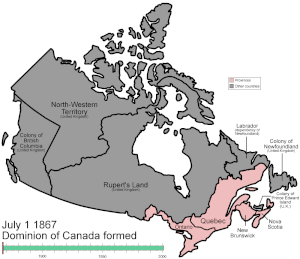
|
An animated image showing the territorial evolution of Canada, that is, the dates when each province and territory were created. Since it was formed, Canada's external borders have changed six times, and it has grown from four provinces to ten provinces and three territories. It has only lost territory in the small border dispute with the Dominion of Newfoundland over Labrador, which joined Canada some time later. Image credit: Golbez |
July 2
[àtúnṣe àmìọ̀rọ̀]| Àwòrán Ọjọ́ Òní | |
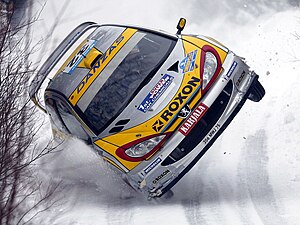
|
Juuso Pykälistö, driving a Peugeot 206 WRC at the 2003 Swedish Rally, lands a high-speed "yump" on two wheels in the snow. This rally competition is part of the World Rally Championship and was the first rally to be held on snow. Photo credit: Christopher Batt |
July 3
[àtúnṣe àmìọ̀rọ̀]| Àwòrán Ọjọ́ Òní | |
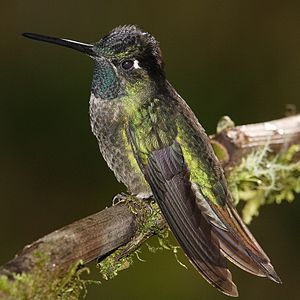
|
The Magnificent Hummingbird (Eugenes fulgens, female shown here) is a large hummingbird that breeds in mountains from the southwestern United States to western Panama. The bird appears very dark unless the sun catches the iridescence of the plumage and the brilliant colours flash in the sunlight. It is generally about 13 cm long, with males weighing 10 g and females 8.5 g. The black bill is long and slightly curved. Photo credit: Mdf |
June 4
[àtúnṣe àmìọ̀rọ̀]| Àwòrán Ọjọ́ Òní | |

|
An animated image showing the U.S. states by date of statehood, that is, the date when each U.S. state joined the Union. Although the first 13 states can be considered to be members of the United States from the date of the Declaration of Independence, they are presented here as being "admitted" on the date each ratified the present United States Constitution. The secession of states to form the Confederacy is not addressed here. Image credit: Astrokey44 |
July 5
[àtúnṣe àmìọ̀rọ̀]| Àwòrán Ọjọ́ Òní | |

|
The Tawny Owl (Strix aluco) is a species of owl resident in much of Europe and southern Russia. It is a medium-sized earless owl, 37-43 cm in length with an 81-96 cm wingspan. The Tawny Owl is stocky with a large rounded head and rounded wings. This species probably injures more people than any other European bird. It is fearless in defence of its nest and young, and strikes for the intruder's face with its sharp talons. Since its flight is silent, at night in particular it may not be detected until too late. Photo credit: K.-M. Hansche |
July 6
[àtúnṣe àmìọ̀rọ̀]| Àwòrán Ọjọ́ Òní | |

|
A path of unshelled pecans makes its way through a host of shelled ones. Pecans can be eaten fresh or used in cooking, particularly in sweet desserts, such as the pecan pie, a traditional southern U.S. recipe. Pecans are also a major ingredient in praline candy. The U.S. produces between 80% and 95% of the world's pecans, with an annual crop of 150-200 million kg (300-400 million pounds). Photo credit: Scott Bauer, ARS |
July 7
[àtúnṣe àmìọ̀rọ̀]| Àwòrán Ọjọ́ Òní | |

|
The brise soleil on Santiago Calatrava's Quadracci Pavilion of the Milwaukee Art Museum in the open position. French for "sun break", a brise soleil serves to provide shade from the sun. Calatrava's brise soleil opens up for a wingspan of 217 feet (66.1 m) during the day, folding over the tall, arched structure at night or during inclement weather. Photo credit: Michael Hicks |
July 8
[àtúnṣe àmìọ̀rọ̀]| Àwòrán Ọjọ́ Òní | |

|
|
|
A view of the Second Severn Crossing, as seen from Severn Beach, England. This bridge carries the M4 motorway across the River Severn between Severn Beach and Caldicot in south Wales. It has a total span of 5.1 km and includes a cable-stayed section called the Shoots Bridge which spans the shipping channel between the two towers. The River Severn has a vast tidal range—the point from which this photograph was taken is covered at high tide. Photo credit: YFB | |
July 9
[àtúnṣe àmìọ̀rọ̀]| Àwòrán Ọjọ́ Òní | |

|
Vernal Fall is a 317 ft (97 m) tall waterfall on the Merced River just downstream of Nevada Fall in Yosemite National Park, California, USA. It is accessible via the Mist Trail, which climbs close enough to the fall so that hikers must travel through the fall's mist. The waterfall runs all year long, although by the end of summer, it is substantially reduced in volume and can split into multiple strands, rather than a single curtain, of water. Photo credit: God of War |
July 10
[àtúnṣe àmìọ̀rọ̀]| Àwòrán Ọjọ́ Òní | |

|
General Douglas MacArthur signs the Japanese Instrument of Surrender as Supreme Allied Commander during formal ceremonies on the USS Missouri in Tokyo Bay. Behind General MacArthur are Lieutenant General Jonathan Wainwright and Lieutenant General A.E. Percival. Photo credit: United States Navy |
July 11
[àtúnṣe àmìọ̀rọ̀]| Àwòrán Ọjọ́ Òní | |
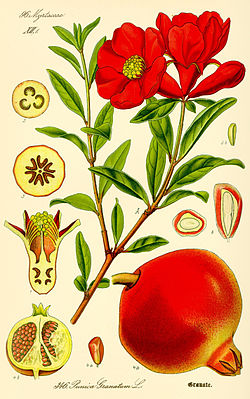
|
An 1885 illustration of pomegranate (Punica granatum) fruit and foliage. Native from Iran to the Himalayas in northern India, the pomegranate is now cultivated mainly in the drier parts of California and Arizona for its fruits exploited commercially as juice products, which have been gaining in popularity since 2001. In the global functional food industry, pomegranate is often mentioned among a novel category of exotic plant sources called "superfruits". Artist: Otto Wilhelm Thomé |
July 12
[àtúnṣe àmìọ̀rọ̀]| Àwòrán Ọjọ́ Òní | |
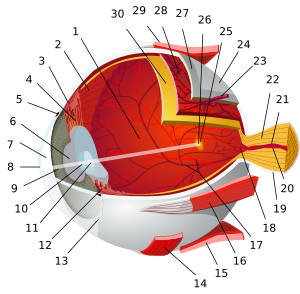
|
Agbeyewo-inu ojú omo-eniyan. Image credit: Chabacano |
July 13
[àtúnṣe àmìọ̀rọ̀]| Àwòrán Ọjọ́ Òní | |

|
Female internees practicing calisthenics at Manzanar War Relocation Center, California. In 1943, Ansel Adams was invited to photograph the everyday life of the Japanese American internees in the camp. Adams' intent was to "show how these people, suffering under a great injustice, (…) had overcome the sense of defeat and despair by building for themselves a vital community in an arid (but magnificent) environment." Photo credit: Ansel Adams |
July 14
[àtúnṣe àmìọ̀rọ̀]| Àwòrán Ọjọ́ Òní | |
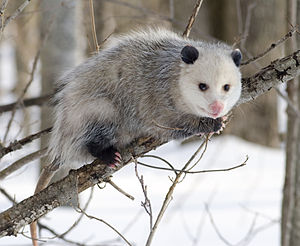
|
The Virginia Opossum (Didelphis virginiana) is the only marsupial found in North America. A solitary and nocturnal animal about the size of a domestic cat, it is a successful opportunist and is found throughout North America from coast to coast (introduced to California in 1910), and from Central America and Mexico to southern Canada. Photo credit: Cody Pope |
July 15
[àtúnṣe àmìọ̀rọ̀]| Àwòrán Ọjọ́ Òní | |

|
The Holdridge life zone climate classification scheme. Professor Holridge developed this model based on three indicators: Mean annual biotemperature, total annual precipitation, and the ratio of mean annual potential evapotranspiration to mean total annual precipitation. Image credit: Peter Halasz |
July 16
[àtúnṣe àmìọ̀rọ̀]| Àwòrán Ọjọ́ Òní | |
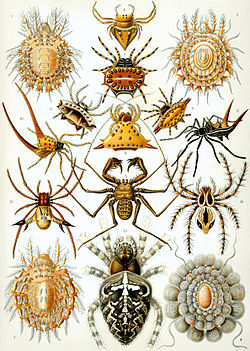
|
The 66th plate from Ernst Haeckel's Kunstformen der Natur (1904), depicting organisms classified as Arachnida. This book of lithographic and autotype prints consists of 100 prints of various organisms, many of which were first described by Haeckel himself. Fifteen different arachnids from various orders are included in this illustration. Image credit: Ernst Haeckel |
July 17
[àtúnṣe àmìọ̀rọ̀]| Àwòrán Ọjọ́ Òní | |

|
An image of the top layers of Earth's atmosphere leading to outer space. Atmospheric gases scatter blue wavelengths of visible light more than other wavelengths, giving the Earth’s visible edge a blue halo. At higher and higher altitudes, the atmosphere becomes so thin that it essentially ceases to exist. Gradually, the atmospheric halo fades into the blackness of space. Photo credit: NASA Johnson Space Center |
July 18
[àtúnṣe àmìọ̀rọ̀]| Àwòrán Ọjọ́ Òní | |

|
This animation shows a classic example of homeomorphism: a coffee mug and a torus are topologically the same. Roughly speaking, a topological space is a geometric object and the homeomorphism is a continuous stretching and bending of the object into a new shape. The traditional joke is that topologists can't tell the coffee cup from which they are drinking from the donut they are eating, since a sufficiently pliable donut could be reshaped to the form of a coffee cup by creating a dimple and progressively enlarging it, while shrinking the hole into a handle. Image credit: Kieff |
July 19
[àtúnṣe àmìọ̀rọ̀]| Àwòrán Ọjọ́ Òní | |

|
The morphology and locomotive system of Equus callibus (a common horse). Because horses and humans have lived and worked together for thousands of years, an extensive specialized vocabulary has arisen to describe virtually every horse behavioral and anatomical characteristic with a high degree of precision. Horse anatomy comes with a large number of horse specific terms. Image credit: WikipedianProlific |
July 20
[àtúnṣe àmìọ̀rọ̀]| Àwòrán Ọjọ́ Òní | |

|
A picture of cutlery made of biodegradable plastic. The image was created using photoelasticity, an experimental method to determine stress distribution in a material. The method is based on the property of birefringence, which is when a ray of light passing through a transparent material experiences two refractive indices. Photo credit: Scott Bauer, ARS |
July 21
[àtúnṣe àmìọ̀rọ̀]| Àwòrán Ọjọ́ Òní | |

|
Sather Tower on the campus of the University of California, Berkeley, as seen from California Memorial Stadium at sunset. The campanile (bell and clock tower), home of a full concert 61-bell carillon, serves as the school's most recognizable symbol and has been a major point of orientation in almost every campus master plan. The tower has thirteen floors, with the observation deck on the eighth. Photo credit: Tristan Harward |
July 22
[àtúnṣe àmìọ̀rọ̀]| Àwòrán Ọjọ́ Òní | |
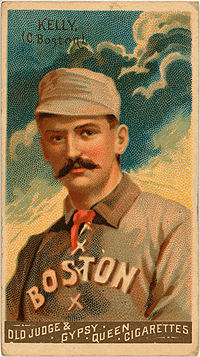
|
An 1888 baseball card of King Kelly, a catcher for the Boston Beaneaters, part of a 50 card set depicting athletes from a variety of sports, including eight baseball players. This is an early example of the use of pointillism in printmaking to create a wide variety of colors with a small number of plates. The pointillist technique was later advanced to create halftoning and Benday dots. Card produced by Goodwin & Company |
July 23
[àtúnṣe àmìọ̀rọ̀]| Àwòrán Ọjọ́ Òní | |
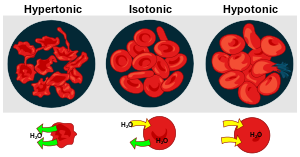
|
An illustrating showing the effects of osmotic pressure on red blood cells. On the left, the cells are in a hypertonic environment, causing water to flow across the cell membrane out of the cell. Cells are shown in an isotonic environment in the center, and in an hypotonic solution on the right. Image credit: Mariana Ruiz |
July 24
[àtúnṣe àmìọ̀rọ̀]| Àwòrán Ọjọ́ Òní | |
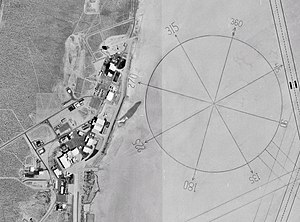
|
The world's largest compass rose, drawn on the desert floor at Edwards Air Force Base in California, United States. Painted on the playa near Dryden Flight Research Center, it is inclined to magnetic north and is used by pilots for calibrating heading indicators. Photo credit: NASA |
July 25
[àtúnṣe àmìọ̀rọ̀]| Àwòrán Ọjọ́ Òní | |

|
|
|
A panorama of a portion of the Las Vegas Strip at night (facing east), as seen from the Bellagio. Despite the name, the majority of The Strip is not actually within the city limits of Las Vegas, Nevada. Visible in the image are (left to right) Bally's, Paris, Aladdin (now Planet Hollywood), MGM Grand, Monte Carlo, New York-New York, the Project CityCenter construction site, as well as a number of other smaller hotels and casinos. Photo credit: Matt Field | |
July 26
[àtúnṣe àmìọ̀rọ̀]| Àwòrán Ọjọ́ Òní | |

|
|
|
A mammatus cloud formation over Swifts Creek, Victoria, Australia. The name "mammatus" derives from the Latin mamma, or breast, due to their rounded, hanging shape. Mammatus clouds only occur where cumulonimbus are present and are often the byproduct of strong storm activity. Detailed observations of mammatus have been meager and usually occur only by chance, since they do not pose a meteorological threat to society. Photo credit: Fir0002 | |
July 27
[àtúnṣe àmìọ̀rọ̀]| Àwòrán Ọjọ́ Òní | |

|
A portrait of Golda Meir from 1973, during her tenure as Prime Minister of Israel. She was the first (and, to date, only) female Prime Minister of Israel, and was the third female Prime Minister in the world, as well as one of the founders of the State of Israel. Born as Golda Mabovitz, she chose her Hebrew name "Meir" upon her appointment as Foreign Minister in 1956. As Prime Minister, Meir oversaw a tumultuous period in Israeli history, with the War of Attrition, Operation Wrath of God, and the Yom Kippur War, all happening during that time. Photo credit: Marion S. Trikosko, U.S. News & World Report |
July 28
[àtúnṣe àmìọ̀rọ̀]| Àwòrán Ọjọ́ Òní | |

|
A man exemplifying anti-Iranian sentiment during a 1979 Washington, D.C. student protest of the Iran hostage crisis. His raised sign reads "deport all Iranians, get the hell out of my country" and "Release all Americans now" on the reverse side. Photo credit: Marion S. Trikosko, |
July 29
[àtúnṣe àmìọ̀rọ̀]| Àwòrán Ọjọ́ Òní | |
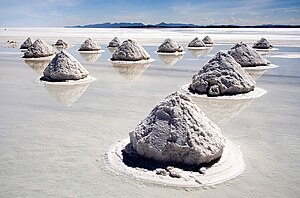
|
Salt mounds in Salar de Uyuni, Bolivia, the world's largest salt flat. It is the remnant of a prehistoric lake surrounded by mountains without drainage outlets. Salt is harvested in the traditional method: the salt is scraped into small mounds for water evaporation and easier transportation, dried over fire, and finally enriched with iodine. Photo credit: Luca Galuzzi |
July 30
[àtúnṣe àmìọ̀rọ̀]| Àwòrán Ọjọ́ Òní | |

|
A black-tailed prairie dog at the National Zoo in Washington, D.C., looks out from a system of burrows, characteristically scanning the horizon. On average, these rodents grow to between 12 and 16 inches (30 and 40 cm) long, including their short tails. Photo credit: Aaron Siirila |
July 31
[àtúnṣe àmìọ̀rọ̀]| Àwòrán Ọjọ́ Òní | |

|
This watercolor painting shows Cleveland Tower on the campus of Princeton University in Princeton, New Jersey as seen from just outside Procter Hall at the Old Graduate College in the noon autumn sun. The tower was built in 1913 as a memorial to former United States President Grover Cleveland, who also served as a university trustee. One of the largest carillons in the world, the class of 1892 bells, was installed in 1927. The Chapel Music program plays the bells Sunday afternoons during each semester, except during exam periods. Artist: David Liao |
